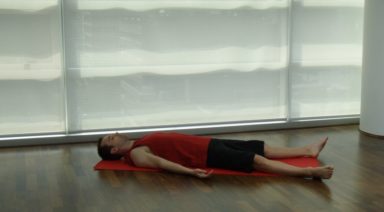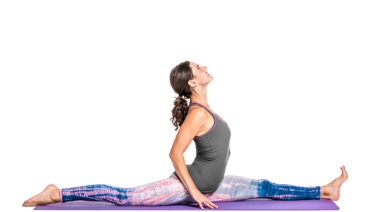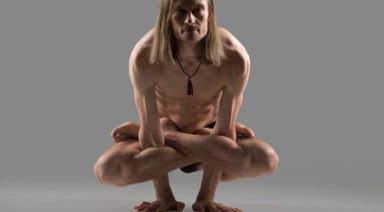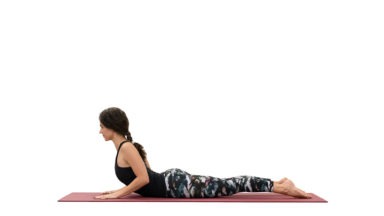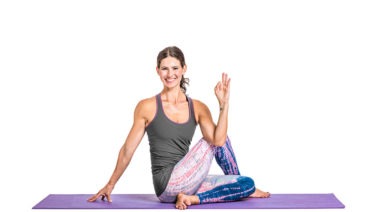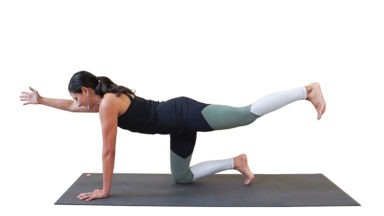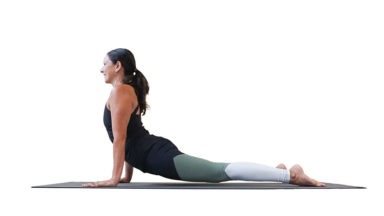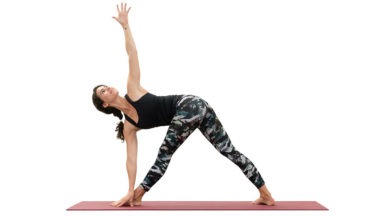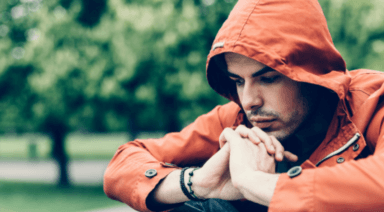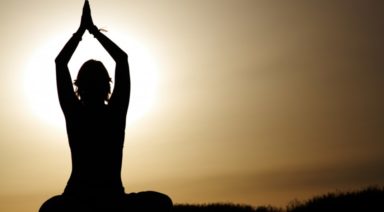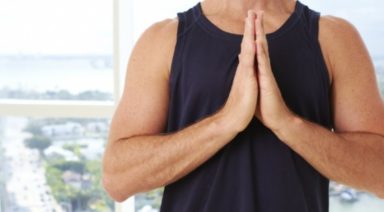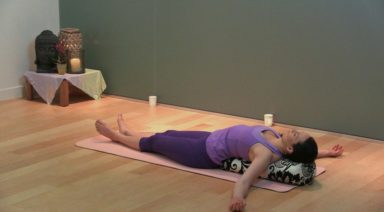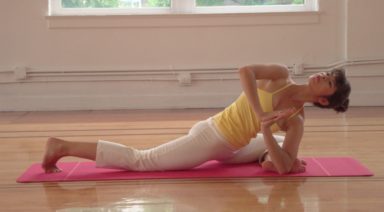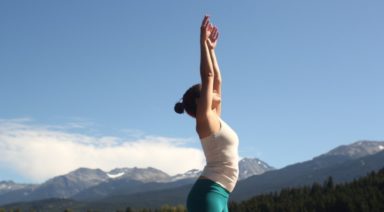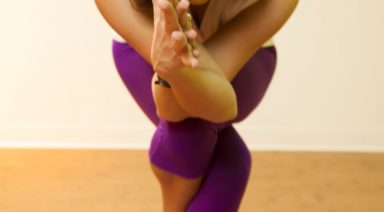Restorative Yoga Poses that Anyone Can Do

The practice of restorative yoga can be a key component is creating ease and relieving stress in your everyday life, especially if you are recovering from an illness of injury.
As Andrea Marcum, owner of U Studio Yoga studio in Los Angeles says, “We use this [restorative] practice to connect with ourselves, as well as to connect with something greater.” She also suggests that as we relax into the restorative poses, we feel the dust begin to settle in our minds. When the dust settles, the mind becomes unclouded. Like a clear pool of water, which Marcum notes, “clear pools of water reflect the beauty of the surroundings.”
Her A,B,C’s of Breathing are brilliant in their simplicity, a key component of a restorative practice.
Awareness – having knowledge or consciousness Benevolence – kindness – the desire to do well to others Calm – tranquility – free from agitation
I consider this to be the path from the individual to the universal.
Or, more simply, that a restorative state helps us move beyond self-centeredness; from a state of ‘me’ consciousness to a ‘we’ consciousness.
In our typically busy lives, our nervous systems get over-stimulated. It’s as if our bodies are constantly on a cross-country road trip, in overdrive. Like a much-needed rest stop for our nervous systems, try these restorative yoga poses as recommended by Shannon Paige in her Anjali Restorative Chakra Roots to Rise.
To try the following six restorative poses you’ll need a blanket and a bolster.
Remember, you can create a bolster by simply rolling two blankets together. Create a neck roll by folding one of the outstretched blankets in half. The fold will form a large rectangle shape. Take one of the long edges of the rectangle and begin rolling it, about halfway.
Supported Reclining Pose
Place the blanket at the head end of your yoga mat. The rolled portion will support your neck, and your head can softly rest onto the remaining portion of the unrolled blanket. Adjust the bolster the width of your mat about 2/3 away from the blanket; it’ll go behind your knees to elevate your lower legs. Make sure your knees are wide.
Lay onto your back, ensuring that the bolster and blanket are in comfortable positions. Use your exhales to help you soften into the props and ground beneath you.
To transition out of this pose, bend your knees, bringing your feet onto the bolster. Roll your body onto the right side into a brief fetal position. You can rest your head on your right arm, and keep knees bent. When ready, turn towards the floor with a heavy head to keep softness in your neck, and rise to an upright position.
Elevated Caterpillar Pose
From a seated position, with wide legs over the bolster as in previous pose, drape your torso forward. If it feels as though your pelvis is rocking back, you can sit on top of the blanket roll that supported your neck in supported reclining pose. Rest your head on stacked hands or, if accessible, on the bolster between your knees.
To transition out of this pose, bring your hands beneath your shoulders, pads of the fingers press into the floor to lift your rounded torso up. Allow your head to come up last.
Side Fish
Place the fully rolled up blanket towards the head end of your mat. Move the bolster behind you, the width of mat. From seated, turn towards the right, your right thigh will be parallel to the width of the bolster. Pinwheel your legs so your right foot is in line with your left knee. You can pad your inner left knee if needed. Line up the right side of your torso, so when you lay on to the bolster, the right side of your ribs meet the bolster. Extend your right arm overhead on top of the blanket roll, and wrap the excess blanket roll on top of your arm, so your right arm becomes the middle of a blanket sandwich. Rest your head on this ‘sandwich’ so the blanket equally supports your right shoulder and head. Ensure that there’s ample space for the base of your right ribs and right hip to rest onto the mat. Only the middle portion of the right ribs is elevated onto the bolster.
To transition out of this pose, draw your left arm in front of your body, press down through your left fingertips into the floor to lift your rounded spine up. Keep chin towards your chest as you rise. Turn slightly towards your left, so your seat is on the mat. Bend your knees, feet hips width on the mat, and rest your forehead towards your knees for a few breaths. Then set up for Side Fish to the left.
Belly on Bolster Twist
Place the bolster vertical, from head end of mat to middle of the mat. Sit on your left hip (legs in side fish position), with hands either side of the bolster. From your navel, turn your torso towards the bolster and lay down onto it. Your head can rest to either side or you may like to stack your hands and rest your forehead onto them.
To transition, come out the same way you came into it. Before taking the twist to the other side, you may like to recline back onto the bolster, knees bent, feet wide, or simply stay upright for a few breaths. Then take Belly on Bolster Twist to the other (right) side. We typically take twists following the direction of our digestion: from right to left.
Supported Reclining Butterfly
From an upright-seated position, place the bolster vertical behind you; you may like to elevate the head end with a block, or use a blanket to rest your head onto. Bring the soles of your feet together, and wrap the blanket roll over the tops of your feet, and wrap the ends behind your heels and ankles. You may like to support the outer knees with blocks. Lower your back onto the bolster behind you.
To transition, bring hands to outer knees and draw knees in (blanket will fall away from your feet). Press your thighs away, creating the sensation of spaciousness in your low back. To rise, use your hands on either side of bolster, to lift up.
Supported Child’s Pose
From a seated position, bring the bolster out in front of you, lengthwise. You can place the blanket roll behind the knees for more support (you may want a block under your seat if knees are sensitive), or beneath the tops of the feet. Bring your knees the width of the mat, big toes touching, rest hips on heels and fold forward so your torso rests the length of the bolster.
To transition, roll yourself back upright. Option to take neck stretches: slowly draw right ear towards right shoulder, right arm outstretched. Use your right hand on your right check to lift your head back to center. Then slowly move to the other side.
The Ultimate Stay-cation
We often think that relaxation and de-stressing requires a day at a spa or a month-long Caribbean holiday. Don’t get me wrong, you can sign me up for either of those anytime, but we all need solutions that are cheaper to afford, easier to plan and don’t require a passport. Restorative yoga poses and breathing techniques can be added to your yoga practice anytime, anywhere. Cultivating a consistent restorative yoga practice can have a deep and measurable affect on decreasing stress and anxiety. Just think of it as the ultimate Stay-cation.
Yoga for Insomnia

Not getting enough sleep or waking up in the middle of the night is the worst, except maybe not being able to get to sleep in the first place. Tossing and turning when all you want to do is catch some much needed zzzzzzzs is miserable. Lack of sleep can also increase risk of illness and decrease productivity. Roughly 60 million Americans are affected by chronic sleeplessness; women and people over the age of 65 are disproportionately impacted by this disorder.
There are a million reasons sleep can be elusive. Perhaps you have too much on your mind or maybe you are already anxious about everything you need to accomplish the next day. You also could be dealing with a more serious condition like insomnia. For a chronic problem, see your physician, but there are also some simple things you can do to combat occasional sleeplessness.
Insomnia runs in my family. If I have learned anything from my family members, it is that sleeplessness is more about getting your mind right and adjusting your daily habits and less about knocking yourself out with medication.
Why Yoga for Sleep?
According to Science Daily, “sometimes called the rest and digest system, the parasympathetic system conserves energy as it slows the heart rate, increases intestinal and gland activity, and relaxes sphincter muscles in the gastrointestinal tract”. The parasympathetic nervous system (PNS) is responsible for involuntary movement, which means you don’t always know when it is working and when it is struggling to keep up or is blocked. The PNS controls crying, salivation, urination, and digestion and works when it is at rest. Insomnia can dramatically decrease your PNS’s ability to function at full capacity.
Fortunately, the benefits of yoga, such as lowered stress, reduced blood pressure and better circulation, increase the activation of the PNS leading to better mental relaxation and better sleep.
One technique you may consider for preventing those sleepless nights is a regular yoga practice, especially gentle yoga in the evening. This is probably different from the yoga you practice in a studio. It is similar to restorative yoga in that it concentrates on low tension positions. Think of it more as stretching with a focus on your breath and calming your mind. If you find a few positions you really like, add them into your bedtime routine.
Relaxation is crucial to combatting insomnia. By focusing on your body, you are less likely to let your brain takeover and more likely to put aside the daily stressors to prepare for bedtime. In addition, yoga helps slow your breath, which should leave you feeling more calm. A few poses that are ideal for this include:
Child’s Pose – Balasana
Benefits
A common resting pose to regain control of your breath after a round of more challenging postures or movements, this position has virtues of its own when performed in isolation. It opens your hips, allows for better circulation, and most importantly, helps relax your mind.
Give it a Try
Begin in tabletop pose with your hands and knees on your mat. Your hands should be firmly below your shoulders and your knees below your hips. Next, sit back on your heels and spread your knees to the edges of your mat. While gently lowering your forehead to your mat, reach your hands at the top of your mat. Stay this way for several minutes. Focus on your breath. Breath in and out slowly. Concentrate on every inhale and exhale.
After a few minutes, spread you knees wider, which should sink your head lower into your mat. Stretch your arms farther up your mat and shift your focus to your fingertips. Fan out your fingers and press them into the mat. Remain here for several more minutes, then slowly lift your head and open your eyes. If that felt good, repeat two to three times before climbing into bed.
Supine Spinal Twist – Supta Matsyendrasana
Benefits
Opens your chest and stretches out your leg muscles. Alleviates pain in your lower back. Persistent back pain can often keep you tossing and turning at night.
Give it a Try
You can do this on a mat, soft carpet, or even in bed. Being by lying down on your back with your arms out to the sides, so that your body is in a “T” shape. As you inhale, lift your heels off the ground. Exhale and lower your heels back down, turning your knees to the left side of your body. Keep your knees stacked on top of each other.
Continue to focus on your breath, while turning your head to the right. Allow your right shoulder to press deeper into the mat maintaining the twist through the upper spine. Gently place one hand on top of your knees to deepen the stretch. Hold for at least 20 seconds, but feel free to stay in this position as long as you like, then repeat the stretch on the other side.
Legs Up The Wall Pose – Viparita Karani
Benefits
Lessens menstrual cramps and headaches, relives lower back pain and stress, and reduces the weight off the body which will help ease you into sleep.
Give it a Try
This position requires some set-up. First, grab two large blankets and a small towel/eye mask to put over your eyes. Fold one blanket in half and place it on top of your mat. Both your mat and the folded blanket should be along a wall so that your entire back will fit on top. Then, fold a second blanket thicker than the first and place to the side.
Lie on top of the first blanket with your seat against the wall and legs going up the wall. Place the folded blanket under your seat so that it elevates your seat and keeps your back on the ground. Your body should be in an “L” shape with the floor and the wall, if there is any space, gently shimmy your body forward so that you are making full contact with the wall.
Once your body is positioned, place the small towel/eye mask over your eyes and rest your arms along your sides. Allow your mind to empty. Focus on your breath and enjoy the sensations in your legs, as you stay in this position for about five minutes.
Cat-Cows – Chakravakasana
Benefits
This is a great position before bedtime if you spend most of your day sitting. Quickly builds heat and sheds extra energy to help you ease into sleep.
Give it a Try
Begin in tabletop position (same as Child’s Pose). Make sure your wrists are right under your shoulders and knees under your hips. Let go of any tension in your back and allow your spine to retain a neutral position.
Curl your toes under and tilt your pelvis back. Your seat should be raised, your back in a “U” shape and your gauze should be forward and slightly up towards the ceiling. You are now in the cow pose. Hold for a long exhale.
To transition into the cat pose, uncurl your feet so that your soles are facing up. Tip your pelvis forward and tuck your tailbone. Move your gauze down to your mat, allowing your head to follow and your spine to form an inverted “U.” Pull your navel into your spine and hold. Hold for a long inhale.
Inhale and exhale for several rounds. Remember to form a cat pose on inhale and a cow pose to exhale. Do this for at least three minutes, then rest in child’s pose. If you are still feeling restless, do two or three more rounds just like the first.
Happy Baby – Ananda Balasana
Benefits
Lubricates your joints, calms the mind, and releases tensions in the body.
Give it a Try
This is an easy, fun one. First, lie on your back on top of your mat. Hug your knees into your chest. Take 10-15 seconds in the pose to warm-up your body. Then, grab the soles of your feet (or ankles if grabbing your feet is impossible or uncomfortable). Using your hands, pull your legs apart and to the sides and hold the stretch for another 10-15 seconds. If it feels good, gently rock from left to right. Allow your head and shoulders to press deeper into the mat. Lastly, let go of your feet and return to hugging your knees. Repeat this exercise as many times as desired.
Pigeon Pose – Kapotasana
Benefits
Relieves tension in the chest and shoulders. Also, helps to relieve stress and anxiety.
Give it a Try
Begin the same way as Child’s Pose or Cat-Cows exercise – in tabletop pose with your hands and knees on your mat. Bring your right knee as far forward as it will go comfortably and slide slightly to the right of your body. Your toes should naturally tuck under your seat.
Shifting your focus to your left leg, slide your left leg as far back as possible. Make sure the soles of your feet face upwards. Place your hands on either side of your legs.
Then on exhale, extend your arms forward to the top of your mat, lay your torso down over your right leg, and lower your forehead onto your mat. Stay here for ten breaths. Then, deepen your stretch as much as possible by sinking into your hips and stay for another ten breaths.
Next Steps
You don’t have to resort to expensive, potential harmful prescription drugs to get a good night’s sleep. In addition to the pre-bedtime yoga positions suggested above, there are Ayurvedic sleep remedies and other natural techniques you can use to help you drift off to sleep and stay asleep, including:
- Routine. Routine. Routine. I can’t stress this enough. The simple act of doing your bedtime rituals in the same order can help remind your brain it is time to sleep. Make a list of what you typically do before bed and stick to it as much as possible.
- Your Bedroom. Is your sleeping space conducive to sleeping? If there are any lingering signs of work, get it out of there! Your bedroom should be exclusively used for two things. (I’ll let you read in between the lines on that one.)
- Relaxing Music can help you wind down. You want music that doesn’t have lyrics and won’t keep your mind racing.
- Scents can change your mood. I swear by an aromatherapy scent that I use before bedtime or anytime I am stressed. I have it in lotion, candles, and pillow spray.
- Write it down. Keeping a pen and paper on your nightstand can be an easy way to add things to your to-do and get them off your mind.
- More Yoga. There are other types of yoga that can be beneficial, including Kundalini Yoga and Yoga Nidra.
Yoga Nidra is one of my favorite things in the world. In fact, I treat myself to it for my birthday every year. It is essentially a yoga nap which will have you drifting off to sleep in no time.






